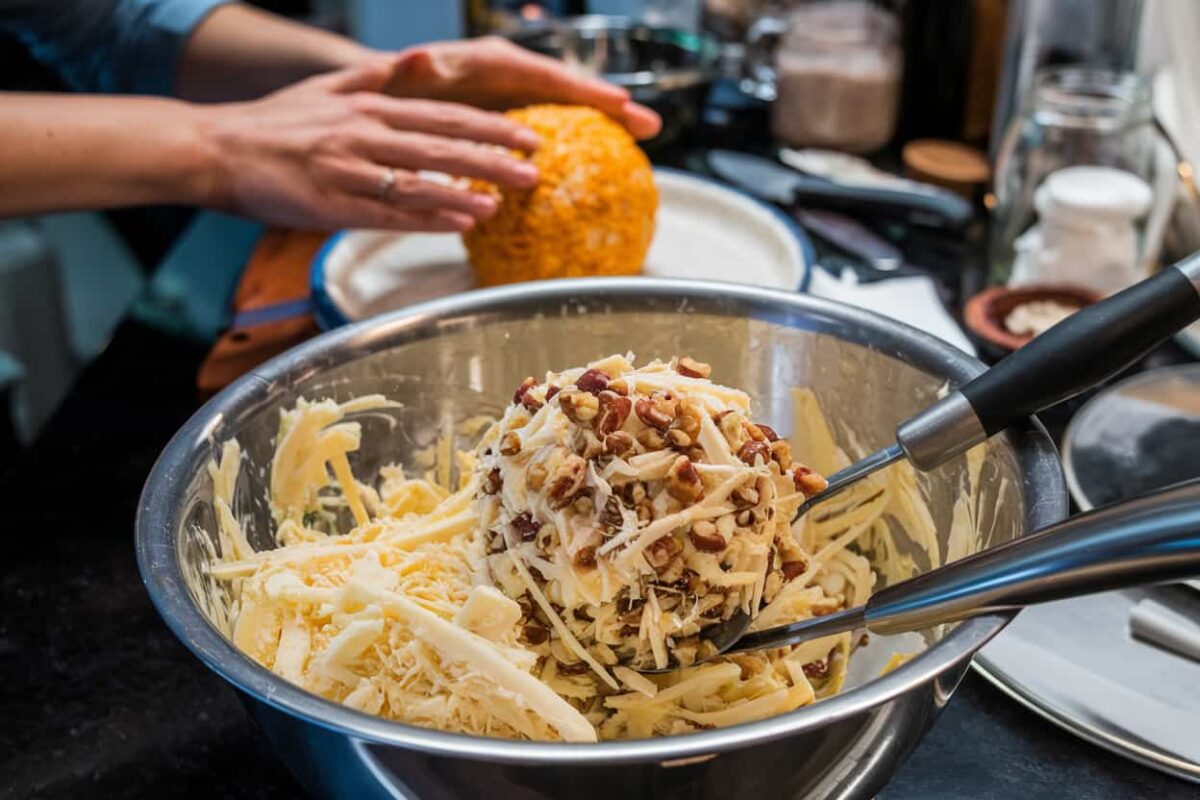Cheese balls are the life of any party, offering a delightful combination of flavors wrapped in a visually appealing sphere. But what happens when your cheese ball doesn’t quite hold up, literally? If you’ve ever asked yourself, “What if my cheese ball is too soft?”, you’re not alone. From minor mishaps to outright disasters, soft cheese balls can feel like a party pooper. Thankfully, there are plenty of ways to fix, prevent, and even creatively salvage them. In this article, we’ll explore the causes of a soft cheese ball, share expert tips for troubleshooting, and uncover innovative solutions to save the day.
Understanding Why Your Cheese Ball Is Too Soft
Common Reasons for a Soft Cheese Ball
Cheese balls are deceptively simple but require a delicate balance of ingredients. A cheese ball may turn out too soft due to several factors:
- Overuse of soft ingredients: Using too much cream cheese or sour cream can lead to an overly creamy, spread-like consistency. These ingredients are essential but should be balanced with firmer components.
- Insufficient chilling time: If you don’t allow your cheese ball enough time to chill, it won’t have the firmness required to maintain its shape. Chilling solidifies the fats, which is key to holding the ball together.
- Improper ingredient ratios: A lack of structure-giving components, such as shredded cheese or crushed nuts, can compromise firmness.
Effects of Room Temperature on Cheese Ball Texture
Temperature plays a critical role in determining the texture of your cheese ball. If exposed to room temperature for too long:
- Fats may soften excessively, causing the ball to lose its firmness and shape.
- Softening accelerates as the cheese reaches its melting point, especially in warm environments.
To combat this, always serve your cheese ball chilled and keep it away from heat sources like sunny windows or warm platters.
Summary of Culprits Behind a Soft Cheese Ball
- Overreliance on soft ingredients.
- Not enough chilling time.
- Environmental factors, like room temperature.
Understanding these causes is the first step to ensuring your cheese ball is picture-perfect for any occasion. Stay tuned for Part 2, where we’ll dive into actionable ways to fix a soft cheese ball!
How to Fix a Cheese Ball That Is Too Soft
Adding Binding Agents to Firm Up the Cheese Ball

If you’ve ever asked, “What if my cheese ball is too soft?”, the solution might be as simple as tweaking your ingredients. Binding agents can transform a gooey cheese ball into a perfect party pleaser. Try these fixes:
- Crushed nuts or breadcrumbs: Mix in finely chopped nuts or breadcrumbs to add structure. Both work as absorbents for any excess moisture.
- Shredded cheese: Adding firm, grated cheese like Parmesan or cheddar provides body and enhances the flavor.
- Cold butter: A few tablespoons of cold, unsalted butter can act as a stabilizer when blended into the mixture.
These small adjustments can ensure your cheese ball holds up better during chilling and serving.
Adjusting Ratios for a Firmer Texture
An unbalanced ratio of ingredients is a common culprit for a too-soft cheese ball. Here’s how to fix it:
- Cut back on soft ingredients: Reduce the quantity of cream cheese or sour cream, as these are prone to making the mixture overly creamy.
- Increase dry components: Powdered garlic, onion, or even a hint of flour can help soak up excess moisture while adding a burst of flavor.
Experiment with small batches until you find the perfect balance.
Refrigeration Tips to Achieve Optimal Texture
Chilling is key to achieving a firm cheese ball. Follow these tips:
- Chill for at least 2 hours: Proper cooling allows the fats in the cheese to solidify, providing much-needed structure.
- Wrap it tightly: Use plastic wrap to maintain shape and prevent the mixture from spreading during refrigeration.
- Shape during cooling: If the cheese ball is still soft after mixing, let it cool for 30 minutes, then reshape for a firmer hold.
Whether you’re using additional binders or relying on refrigeration, these strategies will ensure your cheese ball is firm and ready to impress.
Preventing a Soft Cheese Ball in the Future
Selecting the Right Ingredients
Prevention is always better than a fix, especially when it comes to cheese balls. To avoid asking “What if my cheese ball is too soft?”, start with these tips:
- Choose firmer cheeses: Cheddar, Gouda, or even blue cheese can provide a strong base compared to cream cheese.
- Avoid excess moisture: Steer clear of wet add-ins like overly juicy vegetables or watery sauces. Pat ingredients dry before adding them to the mixture.
Preparing the Cheese Ball Properly
The method of preparation can make or break your cheese ball. Here’s how to do it right:
- Blend thoroughly: Mix all ingredients evenly to ensure a consistent texture. Uneven distribution can cause parts of the ball to feel softer.
- Portion control: If you’re making a large cheese ball, consider dividing it into smaller portions. These are easier to chill and serve without risk of collapse.
By selecting the right ingredients and following a thoughtful process, you’ll ensure your cheese ball maintains its perfect texture, bite after bite.
Creative Ways to Salvage a Soft Cheese Ball
Repurposing Into Cheese Spreads or Dips

When your cheese ball doesn’t hold up as planned, don’t sweat it. A soft cheese ball can still steal the show as a delicious spread or dip. Here’s how:
- Transform it into a spread: Simply scoop the soft mixture into a decorative bowl and serve with crackers, breadsticks, or toasted baguette slices. Adding a drizzle of honey or a sprinkle of herbs can elevate the presentation.
- Enhance with mix-ins: Stir in finely chopped jalapeños, garlic, or dried fruit for a new flavor twist. These add-ons can turn an ordinary dip into something extraordinary.
- Serve as a warm dip: Transfer the cheese mixture into an oven-safe dish, top with shredded cheese, and bake until bubbly. This warm option pairs wonderfully with chips or crudités.
Using as a Stuffing or Topping
Not every cheese ball needs to stay spherical. A soft cheese ball can double as an ingredient for other dishes:
- Stuff mushrooms or peppers: Use the soft cheese mixture as a filling for bite-sized appetizers. Bake until the tops are golden for a crowd-pleasing dish.
- Top baked dishes: Spread the cheese ball over grilled chicken, roasted vegetables, or baked potatoes. The melted cheese adds a creamy, savory finish.
- Turn it into pasta sauce: Whisk the cheese ball into warm cream or milk for a decadent pasta sauce. Add spices like black pepper or nutmeg for a gourmet touch.
Additional Tips and Tricks for the Ultimate Cheese Ball Experience
Incorporating Seasonal Ingredients
Seasonal ingredients can elevate your cheese ball to something extraordinary. Try adding:
- Fresh herbs in the spring, such as dill or chives, for a burst of brightness.
- Cranberries or pecans in the fall for a rich, festive touch.
These additions not only improve flavor but also create a visual appeal that complements any theme.
Presentation Ideas for Maximum Impact
The way you present your cheese ball matters just as much as how it tastes. Try these tips:
- Shape it creatively: Form it into themed shapes, like a pumpkin for fall or a snowman for winter.
- Roll it in a variety of coatings: Crushed nuts, bacon bits, or herbs add texture and visual flair.
- Serve with a variety of dippers: Arrange crackers, veggies, and breadsticks around the cheese ball for an inviting display.
Final Thoughts
Whether you’re fixing a soft cheese ball, preventing one from going wrong, or exploring new ideas, cheese balls offer endless opportunities for creativity. Next time you face a cheese ball conundrum, remember these tips to turn any challenge into a culinary triumph!
Common Mistakes That Lead to a Soft Cheese Ball
Using Too Many Moist Ingredients
One of the most frequent reasons people find themselves asking, “What if my cheese ball is too soft?”, is an overuse of moist ingredients. Cream cheese, sour cream, and yogurt can make the mixture overly soft if not balanced with drier components. While these ingredients add flavor and creaminess, they need to be used in moderation.
To avoid this pitfall, always follow a recipe’s recommended measurements or adjust with additional firm ingredients like shredded cheese or breadcrumbs. Drying any wet add-ins, such as vegetables or herbs, with a paper towel before mixing can also help maintain a firmer texture.
Skipping the Chilling Step
Another common error is underestimating the importance of chilling. Without sufficient refrigeration, the fats in the cheese mixture remain too soft to hold their shape. Always chill your cheese ball for at least 2 hours, and if possible, overnight. For added stability, consider reshaping it midway through the cooling process to ensure the ball stays firm.
Avoiding these common mistakes can save you time and effort while ensuring your cheese ball is a hit every time!
Why a Cheese Ball Is the Ultimate Party Dish
Versatility in Flavor and Presentation
Cheese balls are incredibly versatile, making them a favorite choice for parties and gatherings. Whether you’re hosting a formal dinner or a casual game night, they can be customized to suit any theme or preference. From bold, spicy flavors like jalapeño and cheddar to sweet combinations with cranberries and nuts, the options are endless. Even if you find yourself wondering, “What if my cheese ball is too soft?”, you can repurpose it into spreads or dips without losing its appeal.
Presentation also plays a key role. Rolling your cheese ball in colorful coatings like herbs, nuts, or bacon adds both texture and visual charm, ensuring it stands out on any party platter.
Crowd-Pleasing Simplicity
Cheese balls are not only delicious but also easy to make, often requiring just a few simple ingredients. Their ability to serve a crowd with minimal effort makes them a go-to dish for hosts. Plus, they can be prepared ahead of time, freeing you up for other party tasks.
From their endless flavor possibilities to their ease of preparation, cheese balls truly embody the spirit of effortless entertaining.
FAQs About Cheese Balls
How Long Does a Homemade Cheese Ball Last?
A homemade cheese ball can last up to 5 days in the fridge if stored correctly. Keep it tightly wrapped in plastic or in an airtight container to maintain freshness. Avoid leaving it out for more than 2 hours during serving to prevent spoilage. Signs of spoilage include an off smell, discoloration, or a watery texture.
What to Serve With Cheese Balls?
Cheese balls are versatile and pair wonderfully with an array of snacks:
- Crackers and bread: Thin crackers, crusty baguettes, or toasted pita chips provide the perfect crunch.
- Veggies: Sliced cucumbers, bell peppers, and carrot sticks make for a refreshing pairing.
- Fruits: Grapes, apple slices, or dried apricots complement the creamy texture and add a hint of sweetness.
Where Are Cheese Balls From?
Cheese balls trace their origins to mid-century America, where they became a staple at holiday gatherings. Initially popularized in the 1940s, cheese balls were celebrated for their adaptability and crowd appeal. Today, they’re a global favorite, served at everything from casual picnics to elegant dinners.
How Can I Ensure My Cheese Ball Holds Its Shape?
To keep your cheese ball firm, follow these tips:
- Proper chilling: Always refrigerate for at least 2 hours before serving.
- Add stabilizing ingredients: Use firm cheese, nuts, or breadcrumbs to provide structure.
- Avoid overhandling: Excessive mixing or shaping can soften the cheese mixture, so work quickly and efficiently.
Whether you’re troubleshooting or preparing ahead, these answers should guide you in making the perfect cheese ball every time.
Discover More Recipes for Your Next Meal
If you enjoyed learning about fixing a soft cheese ball, you’ll love exploring other delightful recipes and tips available on Rita Flavors. Here are some suggestions to inspire your next culinary adventure:
Conclusion: Perfecting Your Cheese Ball Game
Recap of Key Fixes and Prevention Tips
Cheese balls might seem simple, but they demand just the right balance of ingredients and preparation to turn out perfectly. If you’ve ever wondered, “What if my cheese ball is too soft?”, you now have a range of solutions at your fingertips. From firming it up with binding agents like nuts or shredded cheese to ensuring adequate chilling time, small adjustments can make a big difference.
Preventing softness in the first place is equally essential. Starting with firmer cheese varieties and balancing soft ingredients with dry ones can save you the trouble of fixing it later. Plus, creative salvage ideas ensure no cheese ball ever goes to waste.
Encouragement to Experiment and Enjoy
Mastering the art of cheese balls takes a little trial and error, but the results are worth it. Don’t be afraid to experiment with flavors, mix-ins, or even entirely new recipes. Whether your cheese ball becomes a dip, a spread, or a main event, it’s sure to impress your guests. Remember, the fun lies in the journey of making it your own!
Happy cooking with Rita chef ❤️!
Print
What If My Cheese Ball Is Too Soft?
- Total Time: 2 hours 15 minutes
- Yield: 8 servings 1x
- Diet: Vegetarian
Description
A cheese ball is a party favorite, but what if it turns out too soft? Learn how to fix, prevent, and enhance your cheese ball with expert tips. Whether you’re making a classic cheese ball or experimenting with new flavors, this guide will help you achieve the perfect texture and taste every time.
Ingredients
Two 8-ounce blocks of cream cheese softened
One cup shredded sharp cheddar cheese
One-fourth cup grated Parmesan cheese
One teaspoon garlic powder
One teaspoon onion powder
One-fourth teaspoon salt
One-fourth teaspoon black pepper
One teaspoon Worcestershire sauce
One teaspoon Dijon mustard optional
One-fourth cup chopped nuts or breadcrumbs for binding if needed
One-fourth cup chopped fresh herbs parsley chives or dill optional
One-half cup chopped pecans almonds or crushed crackers for coating
Instructions
In a large mixing bowl combine the softened cream cheese shredded cheddar Parmesan cheese garlic powder onion powder salt pepper Worcestershire sauce and Dijon mustard if using
Use a hand mixer or spatula to blend the ingredients thoroughly until well combined
If the mixture is too soft add chopped nuts breadcrumbs or more shredded cheese to improve firmness
Shape the cheese mixture into a ball using your hands or plastic wrap
Wrap the cheese ball tightly in plastic wrap and refrigerate for at least two hours or overnight for the best results
Once chilled remove from the refrigerator and roll the cheese ball in chopped pecans almonds or crushed crackers for a flavorful coating
Serve with crackers breadsticks or fresh vegetables
Notes
For a firmer cheese ball avoid adding too much cream cheese or sour cream
Refrigerate for at least two hours before serving to maintain shape
If the cheese ball is still too soft add more dry ingredients like shredded cheese breadcrumbs or crushed nuts
For extra flavor experiment with seasonings like smoked paprika cayenne pepper or dried herbs
- Prep Time: 15 minutes
- Cook Time: Chilling Time 2 hours
- Category: Appetizer
- Method: Mixing and Chilling
- Cuisine: American
Nutrition
- Serving Size: One ounce
- Calories: 120 kcal
- Sugar: 1 g
- Sodium: 180 mg
- Fat: 10 g
- Saturated Fat: 5 g
- Unsaturated Fat: 4 g
- Trans Fat: 0 g
- Carbohydrates: 2 g
- Fiber: 0 g
- Protein: 5 g
- Cholesterol: 25 mg

